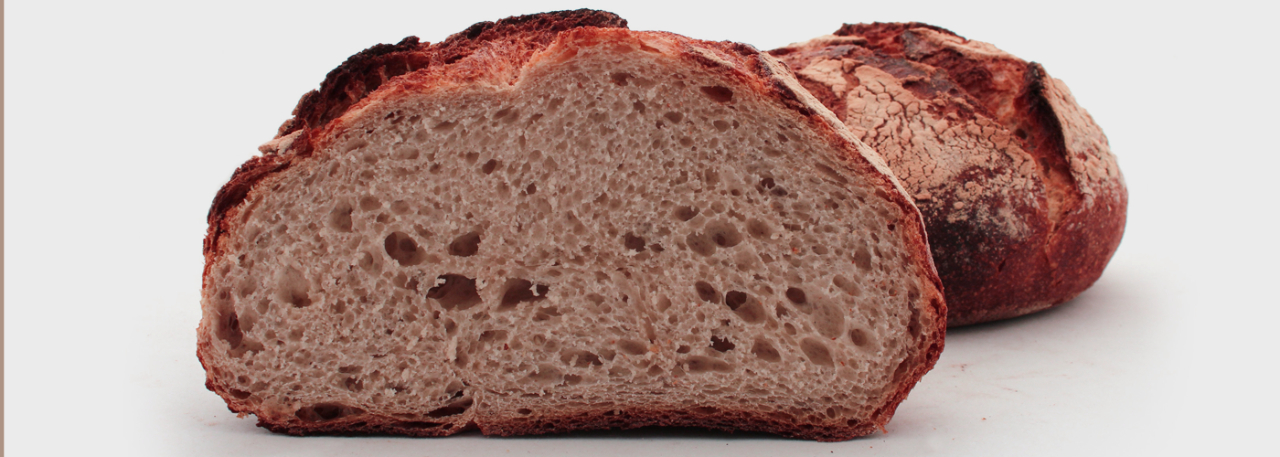.png.transform/rendition-xs/image_image%20(1).png)
Pa de Pagès Català PGI
It is traditional bread, round, with crispy crust, tender crumb and large alveoli, which must always be shaped by hand. It is produced using traditional methods, with slow fermentation, and the dough is always baked in ovens with a refractory floora.
Tasting notes
It is round, rustic-looking bread. The crumb has large and irregular alveoli. It is the same shade of white as the flour that is used and it stays fresh for some time. The spongy crumb is the key feature of the product. The crust is thick and crispy, a toasted brown color, and cracked where it splits open during baking. This bread is very fragrant and tasty, with a certain acidity that keeps it fresh and preserves its pleasant texture even 8-9 hours after coming out of the oven.
Other notes
It is presented in the form of loaves weighing approximately 500 g and 1 kg. They are round, with a natural crack on the top. The bread is sold packaged.
Production / Processing method
Ingredients:
Wheat flour: W between 150 and 240 and P/L between 0.4 and 0.6.
Water: worked into the dough at 60-70% (liters water/kg flour).
Starter dough from a previous fermentation: between 15 and 20% of the amount of flour in the dough.
Yeast (Saccharomyces cerevisiae L.): maximum 2%
Salt: maximum 1.8% (per 100 kg flour)
Specific steps in production that must be carried out in the defined geographical area:
a) Kneading: can be done manually or mechanically. The kneading time varies according to the type of mixer that used, but should take between 20 and 30 min. At first the ingredients are mixed slowly for a few minutes, and then the dough is kneaded faster, as long as required without working it too much.
The temperature of the dough after kneading should be between 22 ºC and 28 ºC, to make sure that it ferments properly afterwards.
b) Leaving the dough to stand: After kneading, the dough is left to stand as a block for at least 15 minutes. The baker’s expertise at this stage is essential to the development of the bread's aroma. This step also favors the strengthening of the proteins developed while the dough was being kneaded and makes it more pliable. The baker’s expertise at this stage is essential to the development of the bread's aroma. This step also favors the strengthening of the proteins developed while the dough was being kneaded and makes it more pliable.
c) Dividing the dough: Next, the dough is divided into pieces. This step can be carried out manually or mechanically. The pieces should have the same weight.
d) Rolling the dough pieces into balls: It can be done manually or mechanically. The pieces must be as uniform as possible.
e) Leaving the balls of dough to stand: It is carried out in ambient conditions, on wood, fabric or baking trays. The balls are left to stand for at least 15 minutes.
f) Shaping: The dough is shaped by pressing it following a process called “fuñido”, until it is shaped like a ball and the folds of dough are at the bottom of the piece, and two small slits can be made in some cases to prevent the formation of bubbles inside the piece. All the formats under this protection are the result of shaping by hand – no mechanized shaping is allowed.
The allowed formats must be the result of shaping by hand – no mechanized shaping is allowed.
g) Rising: Once the piece has been shaped, it should be left to rise continuously, for at least 3 hours. The dough should be placed on wood, fabric or a baking tray, in controlled rising rooms or in the ambient conditions and humidity of the bakery.
h) Scoring: The pieces are turned without scoring.
i) Baking: The bread protected under the PGI “Pa de Pagès Català” can only be baked in ovens with a refractory floor that diffuse the heat, at a temperature between 180 and 230 ºC. Each baker will use his/her own expertise to add steam, and it will determine the final appearance of the crust.
j) Cooling: When it is baked and taken out of the oven, the bread is left to cool at room temperature and indoor humidity. This step is carried out in well-ventilated containers, following good hygiene practices and for the required amount of time.
The bread is sold packaged. Each loaf of bread is individually wrapped and only paper bags or bags made of any other material that is sustainable, biodegradable and eco-friendly can be used. The bread must be packaged in the establishment where it is sold, just before being sold to the end consumer, as the packaging can accelerate the spread of moisture from the crumb to the crust, causing it to become soft and chewy, less crusty on the outside and less spongy on the inside.
The bread can only be cut into slices (llesques), at the customer’s request, when the bread is purchased.
Geography / Relief and climate
"Pa de Pagès Català", popularly known throughout the Autonomous Region of Catalonia as pa de pagès, is the bread with the longest historical tradition in the region. The etymology of the name pa de pagès can give us a clear idea of its origins: the country. Pagès means farmer in Catalan. Pa de pagès was the product that farmers used to make in rural areas all over Catalonia for their own consumption. It had a strong traditional character because it was made in masías (farmers' country houses) and in the houses in the towns. Professional rural bakers also used to make pa de pagès, as the bread could be preserved perfectly for several days, making it ideal for farmers. The main feature of this round bread is that it is shaped manually, fermented slowly and baked in an oven with a refractory floor. This tradition has been going for more than six centuries.
Regulatory Council
Consejo Regulador de la IGP Pa de Pagès Català
C/ Pau Claris, 134 - 3er i 4rt
08009 Barcelona (Catalonia)
Tel: (+ 34) 685 102 105
secretaria@padepagescatala.org
www.padepagescatala.org
Sources:
- Spanish Ministry of Agriculture
The spongy crumb is the key feature of the product.


- Pa de Pagés 1
- Pa de Pagés 2

Barcelona (Catalonia)
